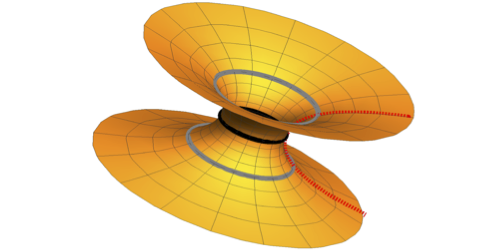May 2, 2016 report
Simulations suggest other phenomenon besides black holes merging could produce gravity waves

(Phys.org)—A team of researchers with the University of Lisbon has created simulations that indicate that the gravitational waves detected by researchers with the LIGO project, and which are believed to have come about due to two black holes colliding, could just have easily come from another object such as a gravaster (objects which are believed to have their insides made of dark energy) or even a wormhole. In their paper published in Physical Review Letters, the team describes the simulations they created, what was seen and what they are hoping to find in the future.
Researchers working on the LIGO project created a lot of excitement earlier this year when they announced that they had made the first ever detection of gravitational waves. Most in the field believe that such waves are, or were, the result of two black holes colliding. But, simulations created in this latest effort suggest that other sources are possible as well.
At issue are ringdowns, which are parts of the gravitational radiation that is emitted when a new but distorted black hole forms and takes shape after two other black holes have collided—as the waves decay a ringdown signal is emitted. But, other events can lead to ringdowns too, the researchers suggest, by so-called black-hole mimics—objects that are extremely compact, but do not have an event horizon—instead, they have light rings. In simulating and then comparing the ringdowns from such objects with those from black holes merging, the team found that under the right set of conditions, the two could be very nearly indistinguishable. But, they also report, as the ringdowns die out, the echoes they create take a long time to die, but as they do, the signal types eventually diverge, offering a means for identifying the original source.
Sadly, data from the LIGO project was not strong enough to show whether the ringdown die out resembled that of the simulated signal from a black hole collision or from some other object. But, going forward, as updates are made to equipment and future signals are detected, it should be possible, the team reports, to spot the differences, if the simulations are correct.
More information: Vitor Cardoso et al. Is the Gravitational-Wave Ringdown a Probe of the Event Horizon?, Physical Review Letters (2016). DOI: 10.1103/PhysRevLett.116.171101 , On Arxiv: arxiv.org/abs/1602.07309
ABSTRACT
It is commonly believed that the ringdown signal from a binary coalescence provides a conclusive proof for the formation of an event horizon after the merger. This expectation is based on the assumption that the ringdown waveform at intermediate times is dominated by the quasinormal modes of the final object. We point out that this assumption should be taken with great care, and that very compact objects with a light ring will display a similar ringdown stage, even when their quasinormal-mode spectrum is completely different from that of a black hole. In other words, universal ringdown waveforms indicate the presence of light rings, rather than of horizons. Only precision observations of the late-time ringdown signal, where the differences in the quasinormal-mode spectrum eventually show up, can be used to rule out exotic alternatives to black holes and to test quantum effects at the horizon scale.
Journal information: Physical Review Letters , arXiv
© 2016 Phys.org



















